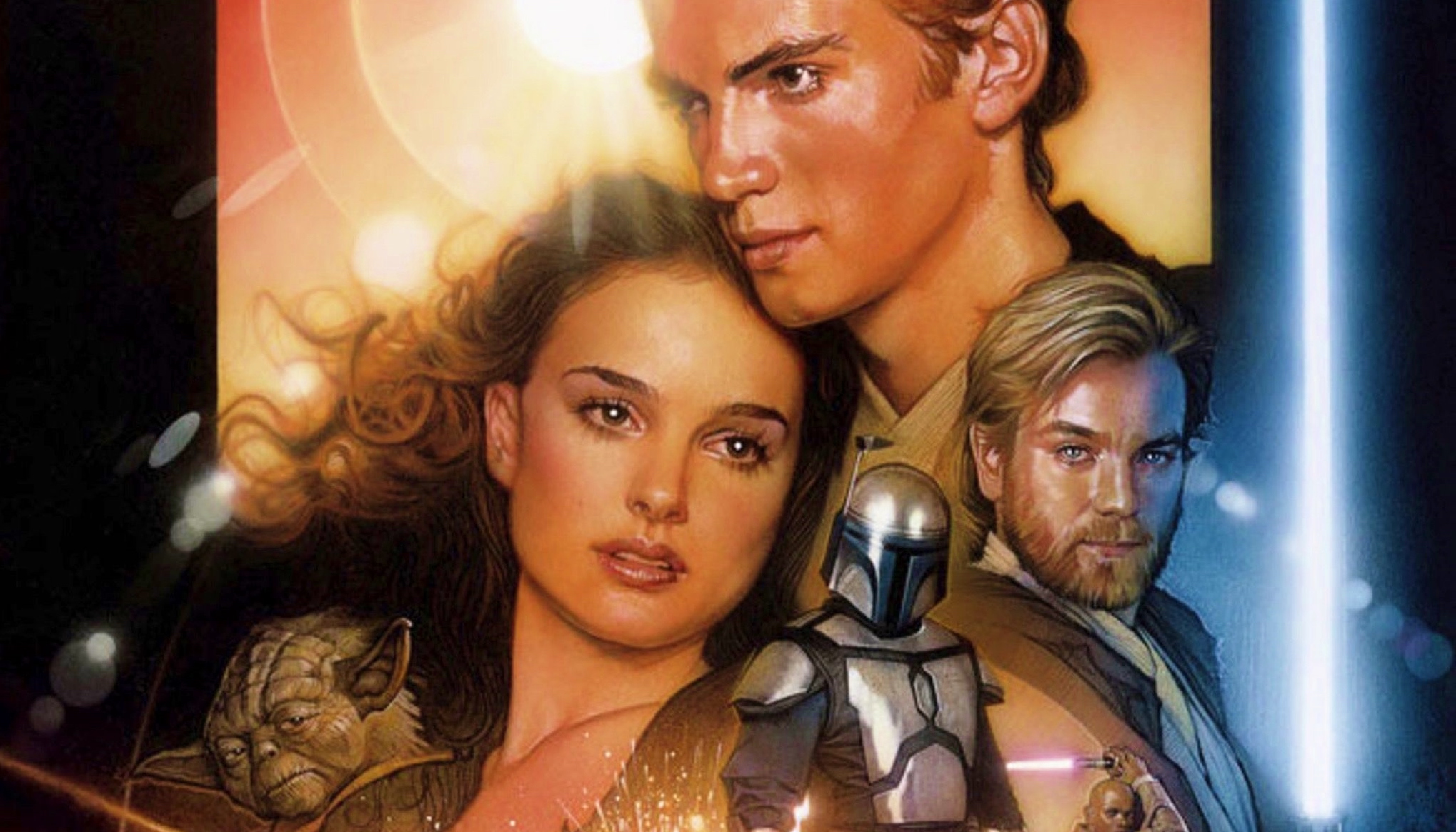
It’s May 4th, the day we celebrate our favorite space-western-samurai-fantasy, Star Wars. But with all the celebration, there’s one part of Star Wars that never gets streamers and a slice of cake. It’s the episode that shows up 10 minutes late at the bottom of every list.
Ladies and gentlemen, I present to you Star Wars Episode II: Attack of the Clones (2002).
But what if this giant ball of Bantha poodoo is actually a hidden gem? What if it’s way better than you remember from the last time you pulled out that old VHS?
Maybe it’s not. But we’re going to try our best to be Luke Skywalker and see the good in this thing.
If you’re suffering as much as I am, please tell me.
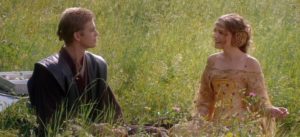 Figuring out how to love Attack of the Clones starts with owning up to some hard truths.
Figuring out how to love Attack of the Clones starts with owning up to some hard truths.
The bad parts of this movie are truly, deeply, bad. They’re coarse, they’re rough, and they get everywhere.
When fans talk about the failures of the Prequel Trilogy, most of those failures come from this movie: the overwrought dialogue, the dry politics, the questionable acting, whatever is happening at Dexter’s Diner. If you ever need a good time, just listen to the audio commentary on the Attack of the Clones Blu-Ray and enjoy the thinly-veiled exasperation of the visual effects team.
Here’s the thing: to love Attack of the Clones, you need to be okay with loving imperfect movies. Any Star Trek fan should already know how to do this.
So in that spirit: what can we celebrate about Attack of the Clones?
My goodness, you’ve grown . . .
 Many adult fans walked out of The Phantom Menace (1999) disappointed, cynical, ready to flood the early internet with opinions. But there was another class of fans.
Many adult fans walked out of The Phantom Menace (1999) disappointed, cynical, ready to flood the early internet with opinions. But there was another class of fans.
Fans like me back then. The kids.
I left Phantom Menace as a fan for life. Attack of the Clones became the first movie I ever anticipated.
I remember the excitement of the new toys coming out, the blue packaging with the white lightsaber. Somewhere, I still have my copy of Star Wars Insider featuring the first sneak peak at Clones. Every new piece of information, every new image or trailer, brought a thrill. Because it was new.
It wasn’t just more battle droids and Gungans. Now we had Clone Troopers, Super Battle Droids, Geonosians, Bounty Hunters—even a new Sith apprentice for Darth Sidious. Our beloved heroes had grown up and changed roles.
In Attack of the Clones, George Lucas gave the trilogy room to evolve. No other movie in the Star Wars Saga took such a massive aesthetic risk.
For kids like me hungry for anything new, this movie told us that Star Wars could go anywhere and be anything. It opened up a galaxy of possibilities.
Still that little franchise we met on Tatooine
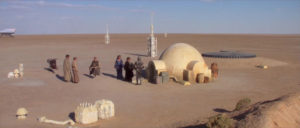 But even with all that new stuff—the stuff that alienated some older fans—this movie stayed true to the deepest roots of Star Wars: the classic adventure serial.
But even with all that new stuff—the stuff that alienated some older fans—this movie stayed true to the deepest roots of Star Wars: the classic adventure serial.
Obi-Wan’s story mirrors the classic, pulpy noir-detective tale, as the excellent “Story and Star Wars” podcast points out. Hence the Dexter’s Diner scene—what good noir detective doesn’t have a man on the street who knows a bit about everything?
Meanwhile, we have the Arthurian-fantasy of Anakin and Padme. Of course, in practice, these scenes don’t quite work (I would make a joke, but I’m much too frightened to tease a senator), but the influence is still there.
At last, it all comes together in a gladiator arena battle straight from Edgar Rice Burroughs.
Lucas doesn’t just try to copy Star Wars. Instead, he returns to the well of pulp-fantasy influences and draws something fresh.
And it does feel fresh. But it all feels like Star Wars.
Begun, the Clone Wars have
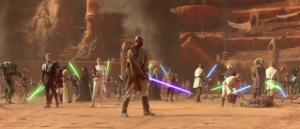 “You fought in the Clone Wars?”
“You fought in the Clone Wars?”
Ever since their first mention in 1977, the Clone Wars filled fans with questions. Just imagine: a whole war with hundreds of Jedi fighting side-by-side. What did that look like? What was the Jedi Order like in its prime? And what was up with the clones? Fans could only imagine.
Until Attack of the Clones.
However you felt about what came before, as soon as the Geonosian arena fills with glowing blades, some part of your Star Wars childhood leaps out of its seat and grabs its plastic telescoping lightsaber.
There’s nothing else quite like this in the rest of the Saga: a massive ground battle with thousands of clones and hundreds of Jedi. It’s everything you imagined it would be.
Add to that the other stunning moments of this film that you didn’t even know you needed: the high-speed chase through Coruscant at night, the battle between Obi-Wan and Jango Fett, Yoda’s lightsaber skills. This movie even introduced Jango Fett’s seismic charges.
That’s why, for all of this movie’s faults, it’s one I’ll always go to if I just want to have fun watching Star Wars.
Much to learn, you still have
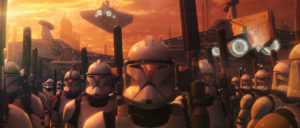 To George Lucas, Star Wars is for children. That might seem like an odd statement from the guy who made an entire movie about trade route taxation.
To George Lucas, Star Wars is for children. That might seem like an odd statement from the guy who made an entire movie about trade route taxation.
But Clones gives us a good sense of the lessons Lucas meant to teach.
We see the dangers of power, as Palpatine receives his first emergency powers to create a clone army. We feel the tension between peace and war, as the Jedi struggle to avoid becoming mere warriors. And we watch Anakin’s fear turn into anger, and then into hate, in one of the strongest emotional beats of the film: the death of his mother, and his slaughter of the Sand People.
These themes lie at the heart of the prequels. Behind the cringeworthy romance and stilted dialogue, there’s a real story that Lucas would go on to develop in Revenge of the Sith and the Clone Wars series.
This Party’s Over
For a generation of fans, the things that define Star Wars come from this most hated of the films. This is why we have Clone Wars, and now Bad Batch (2021). By extension, this is why we have Ahsoka Tano and Bo-Katan. It’s no exaggeration to say that this movie re-invented Star Wars.
Even the film’s worst parts become enjoyable with time as fandom in-jokes. The “I don’t like sand” monologue even found its way into Delilah S. Dawson’s Phasma (2017) novel.
Maybe you still hate this movie. And that’s okay. There’s plenty to hate about it.
But it’s okay to love it, too.
Happy Star Wars day, and May the Fourth be with you.


![[NEWS] TOM HOLLAND GOES INTO ‘UNCHARTED’ TERRITORY NEXT HOLIDAY SEASON](https://geekd-out.com/wp-content/uploads/2019/06/uncharted-4-a-thief-s-end-150x150.jpg)
